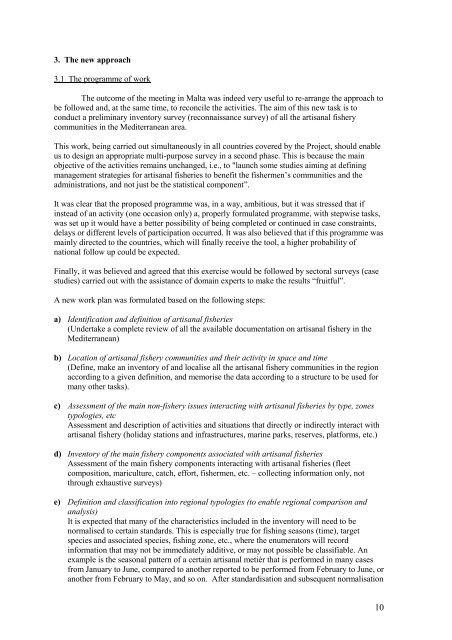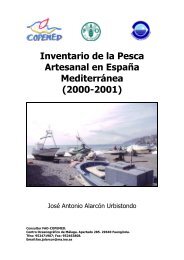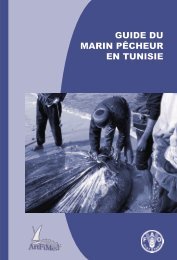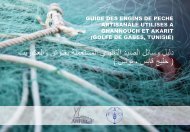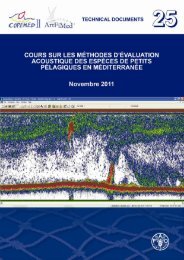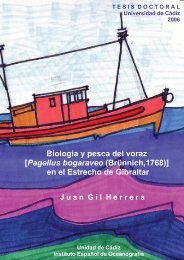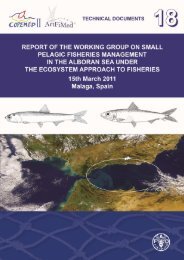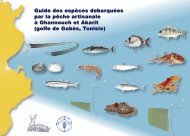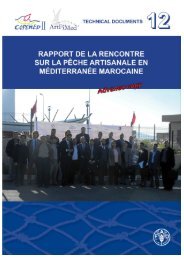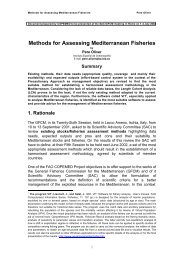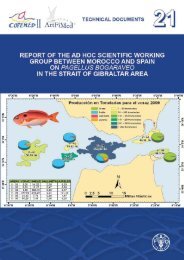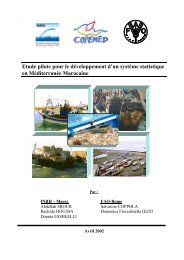Inventory of Artisanal Fishery Communities in the ... - Fao - Copemed
Inventory of Artisanal Fishery Communities in the ... - Fao - Copemed
Inventory of Artisanal Fishery Communities in the ... - Fao - Copemed
Create successful ePaper yourself
Turn your PDF publications into a flip-book with our unique Google optimized e-Paper software.
3. The new approach<br />
3.1 The programme <strong>of</strong> work<br />
The outcome <strong>of</strong> <strong>the</strong> meet<strong>in</strong>g <strong>in</strong> Malta was <strong>in</strong>deed very useful to re-arrange <strong>the</strong> approach to<br />
be followed and, at <strong>the</strong> same time, to reconcile <strong>the</strong> activities. The aim <strong>of</strong> this new task is to<br />
conduct a prelim<strong>in</strong>ary <strong>in</strong>ventory survey (reconnaissance survey) <strong>of</strong> all <strong>the</strong> artisanal fishery<br />
communities <strong>in</strong> <strong>the</strong> Mediterranean area.<br />
This work, be<strong>in</strong>g carried out simultaneously <strong>in</strong> all countries covered by <strong>the</strong> Project, should enable<br />
us to design an appropriate multi-purpose survey <strong>in</strong> a second phase. This is because <strong>the</strong> ma<strong>in</strong><br />
objective <strong>of</strong> <strong>the</strong> activities rema<strong>in</strong>s unchanged, i.e., to "launch some studies aim<strong>in</strong>g at def<strong>in</strong><strong>in</strong>g<br />
management strategies for artisanal fisheries to benefit <strong>the</strong> fishermen’s communities and <strong>the</strong><br />
adm<strong>in</strong>istrations, and not just be <strong>the</strong> statistical component”.<br />
It was clear that <strong>the</strong> proposed programme was, <strong>in</strong> a way, ambitious, but it was stressed that if<br />
<strong>in</strong>stead <strong>of</strong> an activity (one occasion only) a, properly formulated programme, with stepwise tasks,<br />
was set up it would have a better possibility <strong>of</strong> be<strong>in</strong>g completed or cont<strong>in</strong>ued <strong>in</strong> case constra<strong>in</strong>ts,<br />
delays or different levels <strong>of</strong> participation occurred. It was also believed that if this programme was<br />
ma<strong>in</strong>ly directed to <strong>the</strong> countries, which will f<strong>in</strong>ally receive <strong>the</strong> tool, a higher probability <strong>of</strong><br />
national follow up could be expected.<br />
F<strong>in</strong>ally, it was believed and agreed that this exercise would be followed by sectoral surveys (case<br />
studies) carried out with <strong>the</strong> assistance <strong>of</strong> doma<strong>in</strong> experts to make <strong>the</strong> results “fruitful”.<br />
A new work plan was formulated based on <strong>the</strong> follow<strong>in</strong>g steps:<br />
a) Identification and def<strong>in</strong>ition <strong>of</strong> artisanal fisheries<br />
(Undertake a complete review <strong>of</strong> all <strong>the</strong> available documentation on artisanal fishery <strong>in</strong> <strong>the</strong><br />
Mediterranean)<br />
b) Location <strong>of</strong> artisanal fishery communities and <strong>the</strong>ir activity <strong>in</strong> space and time<br />
(Def<strong>in</strong>e, make an <strong>in</strong>ventory <strong>of</strong> and localise all <strong>the</strong> artisanal fishery communities <strong>in</strong> <strong>the</strong> region<br />
accord<strong>in</strong>g to a given def<strong>in</strong>ition, and memorise <strong>the</strong> data accord<strong>in</strong>g to a structure to be used for<br />
many o<strong>the</strong>r tasks).<br />
c) Assessment <strong>of</strong> <strong>the</strong> ma<strong>in</strong> non-fishery issues <strong>in</strong>teract<strong>in</strong>g with artisanal fisheries by type, zones<br />
typologies, etc<br />
Assessment and description <strong>of</strong> activities and situations that directly or <strong>in</strong>directly <strong>in</strong>teract with<br />
artisanal fishery (holiday stations and <strong>in</strong>frastructures, mar<strong>in</strong>e parks, reserves, platforms, etc.)<br />
d) <strong>Inventory</strong> <strong>of</strong> <strong>the</strong> ma<strong>in</strong> fishery components associated with artisanal fisheries<br />
Assessment <strong>of</strong> <strong>the</strong> ma<strong>in</strong> fishery components <strong>in</strong>teract<strong>in</strong>g with artisanal fisheries (fleet<br />
composition, mariculture, catch, effort, fishermen, etc. – collect<strong>in</strong>g <strong>in</strong>formation only, not<br />
through exhaustive surveys)<br />
e) Def<strong>in</strong>ition and classification <strong>in</strong>to regional typologies (to enable regional comparison and<br />
analysis)<br />
It is expected that many <strong>of</strong> <strong>the</strong> characteristics <strong>in</strong>cluded <strong>in</strong> <strong>the</strong> <strong>in</strong>ventory will need to be<br />
normalised to certa<strong>in</strong> standards. This is especially true for fish<strong>in</strong>g seasons (time), target<br />
species and associated species, fish<strong>in</strong>g zone, etc., where <strong>the</strong> enumerators will record<br />
<strong>in</strong>formation that may not be immediately additive, or may not possible be classifiable. An<br />
example is <strong>the</strong> seasonal pattern <strong>of</strong> a certa<strong>in</strong> artisanal metiér that is performed <strong>in</strong> many cases<br />
from January to June, compared to ano<strong>the</strong>r reported to be performed from February to June, or<br />
ano<strong>the</strong>r from February to May, and so on. After standardisation and subsequent normalisation<br />
10


